VOL.51, NO. 1
“There is no Time”: Parsing the Future Perfect in Ted Chiang’s The Story of Your Life and Denis Villeneuve’s Arrival
Gregory Brophy and Shawn Malley
The Hitch Hiker’s Guide to the Galaxy skips lightly over this tangle of academic abstraction, pausing only to note that the term “Future Perfect” has been abandoned since it was discovered not to be.
Douglas Adams, The Restaurant at the End of the Universe (217)
Predicated on a first-contact scenario with a race of space-faring beings, Ted Chiang’s science fiction novella The Story of Your Life (1998, 2016) and Denis Villeneuve’s feature film adaptation Arrival (2016) organize conflict around the theme of communication. Both texts establish tension through the misgivings with which the protagonist, linguistics professor Louise Banks (Amy Adams), and her soon-to-be spouse, theoretical astrophysicist Gary Donnelly (renamed Ian in Arrival [Jeremy Renner]) regard the other’s ability to establish meaningful dialogue with the aliens. In their first exchange in the film, the physicist is bemused by the linguist’s assertion that “language is the cornerstone of civilization” (00:16:20), the position he accords scientific discourse. Settling into the task, however, they develop a mutual appreciation for the language with which each addresses the extra-terrestrials, an interdisciplinary collaboration that anticipates the trans-medial relay between literary and cinematic versions of the story.
Gary’s breakthrough in learning the scientific lingua franca of the “Heptapods,” the moniker adopted for the seven-limbed visitors, comes when his team determines that the aliens’ elementary system of mathematical expression is not algebra but the “calculus of variation,” a complex branch of mathematics used to solve optimization problems like measuring distances between points by calculating all possible variations including their minima and maxima.1 To illustrate for Louise (and the befuddled reader), Gary offers the practical example of light “bending” when it passes from air to water (see Figure 1). He relates that this ordinary observable phenomenon may be described through variation by Pierre de Fermat’s Principle of Least Time, which regards light’s behavior as a function of time rather than of space. The calculus of variation determines the fastest rather than the shortest of all possible pathways light may travel to its destination, an accounting that on first glance appears counterintuitive. Gary explains to Louise that “You’re used to thinking of refraction in terms of cause and effect: reaching the water’s surface is the cause, and the change in direction is the effect. But Fermat’s principle sounds weird because it describes light’s behavior in goal-oriented terms” (124). While “the common formulation of physical laws is causal,” he continues, “a variational principle like Fermat’s is purposive, almost teleological”: the “notion of a ‘fastest path’ is meaningless unless there’s a destination specified” (125). Imagining that “the ray of light has to know where it will ultimately end up before it can choose the direction to begin moving in” (125, emphasis in original), the linguist deduces that the aliens have calculated their path through time as well as space, carefully weighing the variability of their actions against the sum total of their future. The interpretive challenge for Louise, then, is to determine the linguistic equivalent of variational calculus, a language whose teleological logic and syntactical structures are in extreme variance with the principles of causality and temporal linearity that structure human thought and language.
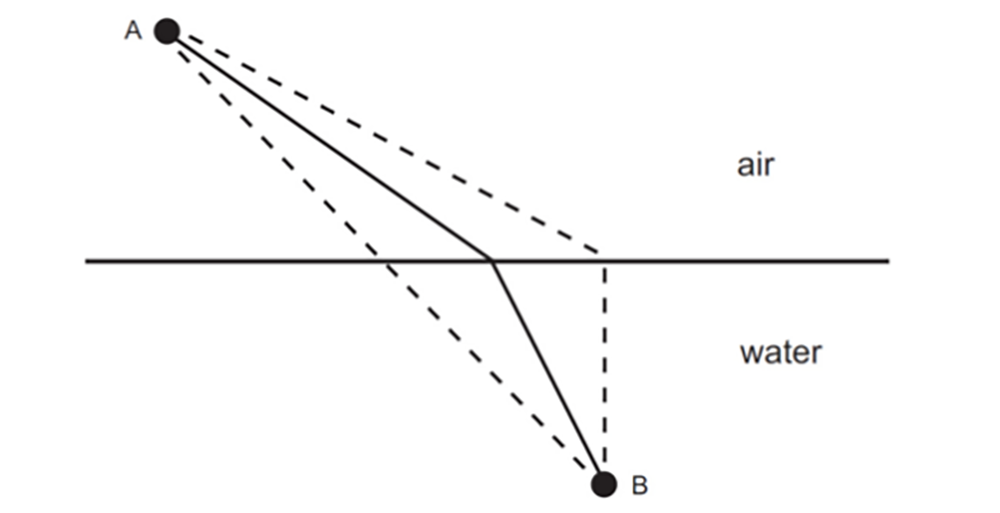
A variation on the science fiction trope of time-travel, the premise of Chiang’s story and Villeneuve’s film is that Louise harnesses the aliens’ power of “simultaneous consciousness” imprinted in their written language (called “Heptapod B” in the novella to distinguish it from their inscrutable speech, “Heptapod A”). As she learns to read Heptapod (see Figure 2), Louise slips in and out of linear time, recalling “memories” of the daughter she has yet to conceive; like Fermat’s ray of light refracting in water, Louise bends time as she spins her story, recounting and recording the minute details of her daughter’s life as if it had passed in its entirety (see Figure 3). But for the linguist, the satisfaction of breaking the Heptapod code is as painfully ambivalent as the grammatical tense through which she both recalls and relates the future in the present: for the Heptapod gift of retroactive prescience presents the linguist with the experience of the future in which she has conceived, birthed and raised a child she knows she will bury. Indeed, has buried.
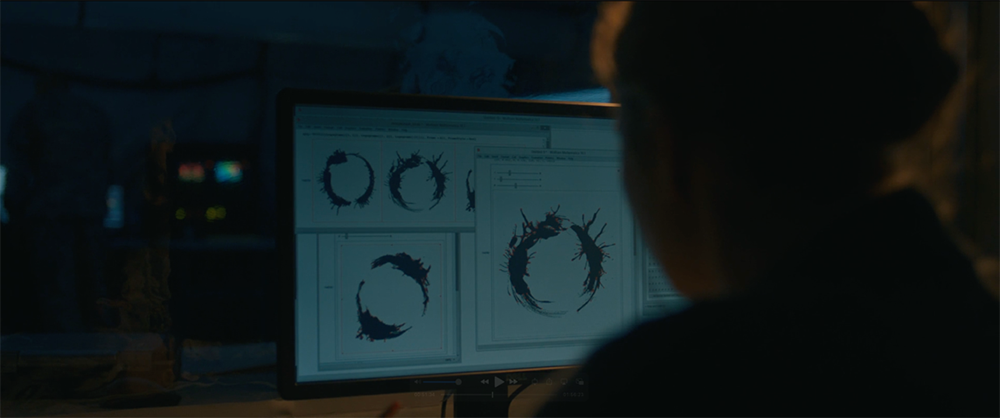
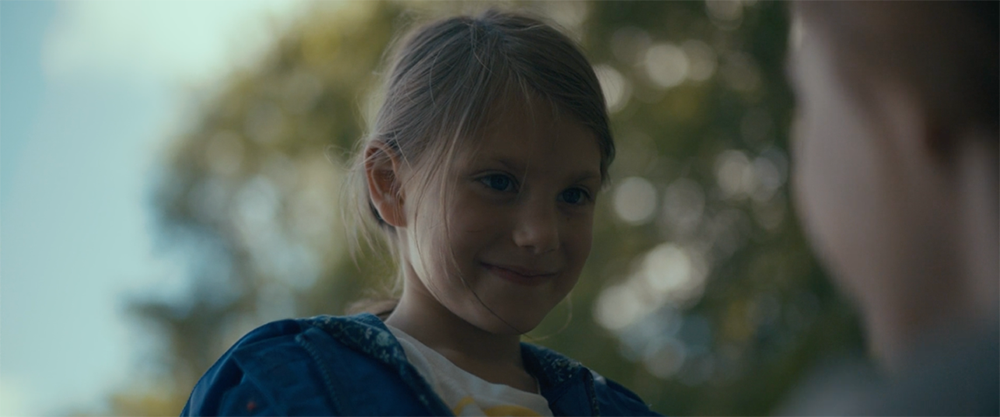
The graph Chiang provides in his novella can also serve as an emblem of the way the narrative passes between media: just as light refracts on its journey from air and water, so too the story would seem to refract at the boundary between literature and film media. On closer inspection, however, the variational principle Gary expounds demands that Louise (and we) step back to regard variation as a system rather than as a point of fracture. The change in medium involves a shift in the angle of approach to a shared end or common purpose—in this case, a differential approach to the expression of simultaneous consciousness, a light bound to find its optimal path through linguistic syntax and film montage. The initial appearance of discontinuity (in Chiang’s composition of the compound-tense sentence, in Joe Walker’s non-linear editing, and in between the texts) yields to the coherence of a larger totality.
Described mathematically by Fermat and felt existentially by the protagonist, the teleological view of time, language, and experience places extreme demands on the adaptive process. As a crooked analogy of navigating simultaneous consciousness across media, Fermat’s Principle raises what Gerry Canavan identifies as “rather vexing adaptation problems” (492). Canavan observes that in “accordance with a filmic logic of sequentiality over simultaneity—one image after another—the implication of the film version of this story seems to be that Louise is still experiencing her life in order even after coming to understand the Heptapods’ way of thinking—just not in standard chronological order.” While Chiang’s non-linear present-tense narrative captures the tortuous experience of simultaneous consciousness, the forward energy of moving pictures imparts “genuine differences in interpretation of what the time travel ‘means’ within the narrative” (495), particularly with respect to the nature of choice. In Chiang’s text, “Louise’s only true ‘choice’ seems to be the way she orients her internal psychology to life events that are entirely inevitable and unalterable.” When Villeneuve’s film transforms this muted alien encounter into a geopolitical apocalypse scenario, the nature of choice adjusts to the demands of the genre: Louise must employ her gift of foreknowledge to save the world, a choice that enables the future in which her daughter can be born to die. Since the “philosophical implications” of agency “are thus in severe opposition in its two media forms,” Canavan concludes that “Chiang’s original story remains in some sense unfilmed and perhaps unfilmable” (496).
Shifting the thematic tension between simultaneity and sequentiality at the heart of Chiang’s story to a consideration of generic variance, Canavan’s characterization of the literary text as at once “original” and “unfilmable” recalls Linda Hutcheon and Gary R. Bartoli’s observation in their 2007 article “On the Origin of Adaptations” that “[a]daptation theory has rarely challenged [the] dismissive evaluation” of “narrative adaptations […] as secondary and derivative” (443). While the refusal of this hierarchy between original and adapted texts reaches back at least as far as Bazin’s essay of 1948, “Adaptation: or, the Cinema as Digest,” and has been a critical commonplace in adaptation studies for decades (cf. Stam 2005, 8-12), the field nonetheless continues to respond to, and is energized by, the “need for new models” (443).2 If for Canavan the aporia of choice undergirding simultaneous consciousness in Chiang’s narrative suggests a media-specific essence of temporality that remains ineffable within the cinematic register, we contend that Fermat’s Principle introduces a novel approach to transmedia variance. Whereas the “fidelity discourse” of adaptation studies (which judges an adaptation’s success according to its faithfulness to the source text) appeals to an ideal origin rooted in the past, Fermat’s paradoxical insight is that this refracted trajectory is anything but linear: Fermat intersects and fragments causal logic with a teleological thrust. Committing to Fermat on the adaptive journey involves asking how the story and film maneuver inexorably towards the same destination incarnate in the future memory of Louise’s still-unborn daughter. To this end we consider how Villeneuve adapts Chiang’s grammatical expression of simultaneous consciousness into the visual and acousmatic properties of film, and, along the way, offer a solution to Canavan’s “unfilmable” problem of choice within the complex temporality of the film image itself. Ultimately, Fermat is a model of adaption that allows us to see time in both media simultaneously.
What Makes Tense so Tense?
I read at the same time: This will be and this has been.
Roland Barthes, Camera Lucida (96)
The point of convergence between these literary and visual texts—and the experience of reading, watching and ultimately thinking through and across media—is most readily discernable in the aliens’ strange writing system. A version of the ideogram, which conveys concepts through graphic images, the fundamental lexical unit of the Heptapods is what Louise terms a “semagram,” a word-image that can be read but not pronounced. The Heptapods “see” time in the visual properties of a language that, like their basic mathematical system, transcends the syntactic constraints of cause and effect and allows them to experience simultaneously the maxima and minima of time, the entire sum of their past, present and future.
Locating a model of adaption in the principle of variation demands close inspection of the modalities through which each text imagines this alien language and its influence on Louise. In The Story of Your Life, Louise and Gary watch Heptapod feeds on an alien instrument known as a “looking glass.” Recalling Lewis Carroll’s Through the Looking Glass, and What Alice Found There (1871), Louise enters a strange reality in which time folds back onto itself like the Jabberwock galumphing through Carroll’s mirror verse. By contrast, Villeneuve’s inversions take place before a translucent screen in a cave-like enclosure that grants the spaceship’s interior a prehistoric feel, as if we had entered the Lascaux caves to marvel over the beginnings of narrative artwork (see Figure 4). This darkened cavern of a cinema, at once archaic and futuristic, supports the film’s “screen-en-abyme” structure, the shadow play behind its screen suggesting a reflexive allegory of mediation, a stage for reflections on film and time. In Villeneuve’s recursive cinema, film returns to writing not as its reflection locked in a mimetic bind, but in a variable partnership that refracts through cinema’s optical effects the redoubling influence of the Heptapod script (see Figure 5).
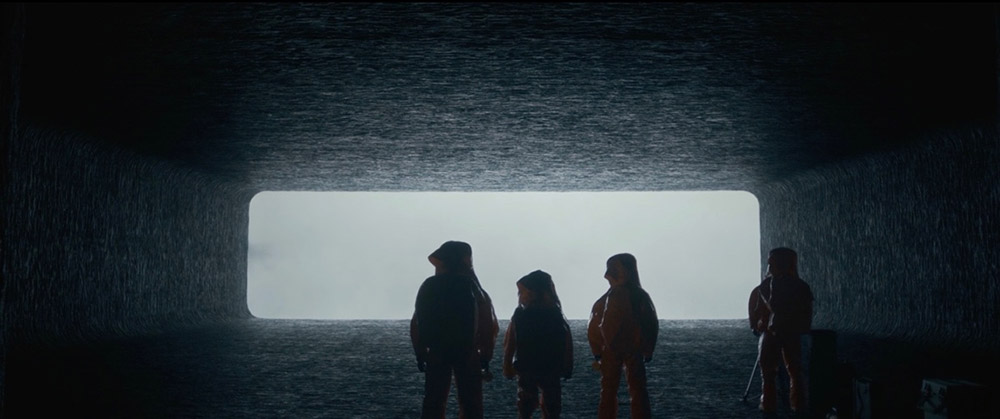

The morphology of the semagram composed on these screens, moreover, could hardly be different. Though Chiang’s text accommodates three diagrams to illustrate Fermat’s Principle (116-17), it oddly offers no visual depiction of the Heptapod script. In the absence of accompanying illustration, Chiang can only describe what Heptapod writing looks like to Louise: “fanciful praying mantids drawn in a cursive style, all clinging to each other to form an Escheresque lattice” (112). Penetrating the declensions churning in this Heptapod stew awakens in Louise the altered experience of simultaneous consciousness and solicits concomitant demands on the English language to communicate this experience. Accordingly, The Story of Your Life tells two stories at once: Louise’s encounter with the aliens, which she relates from the first-person point of view, and her second-person address to her daughter. Formally, the simultaneous narration articulates the science fiction plot of Louise learning Heptapod B and the complementary plot engendered by that knowledge. The second-person address (to the titular “you”) is grammatically and logically “predicated” on the first-person perspective. These narrative vectors replicate the teleological experience of time contained in the Heptapods’ “two-dimensional grammar” (110). Like the Heptapods, Louise creates the future as she relates its history.
In the second-person voice, the sentence is the story’s vehicle, which means that readers get to ride along with Louise and experience the dizziness of time travel by parsing Chiang’s sometimes bewildering sentences. We still scan the story left to right, top to bottom, moving across and down the page as we do through life in linear fashion. But Chiang’s style shuttles us back and forth between future, past and present; his elegant and mystifying sentences hold each tense in suspension by slipping the logic of future perfect into the immediacy of the present tense, a complex predication that challenges the reader to reflect upon a mother’s fateful relationship with her child. The second-person narrative no longer needs to be told from start to finish for Louise, and she grants us the same perspective, outside of the slipstream of linear, causal plotting. For example, Louise relates, “I remember once when we’ll be driving to the mall to buy some new clothes for you. You’ll be thirteen. One moment you’ll be sprawled in your seat, completely unself-conscious, all child; the next, you’ll toss your hair with a practiced casualness, like a fashion model in training” (114). The first sentence begins with a backward glance at the future: “I remember when we’ll be...” Louise’s daughter is thirteen, and like all adolescent bodies (especially in the eyes of their parents), hers holds the vestiges of childhood and intimations of adulthood. We see, in flashes, their history, their manifest presence, and their latent potential. The semicolon in this sentence serves as the fragile hinge between past and future. On the other side of childhood’s innocence lies the “practiced casualness” of the adult, a contradiction that resonates with the story’s larger questions concerning fate and will. Sentences such as this one creatively confound exposition with enactment, as our narrator slips into spontaneous demonstrations of her new consciousness. Louise performs her epiphany through form, a complex future perfect that unfurls kaleidoscopic sentences along the ripples of the story’s temporal paradox.
In Chiang’s novella, the impact of the semagram is felt in the variational modality with which Louise communicates her causal story of learning Heptapod B in parallel with the teleological “story of your life.” But the visual nature of the semasiographic language poses certain challenges to Chiang’s medium, nonetheless. From the reader’s perspective, when Louise reveals that her “thoughts were becoming graphically coded” (127), we have to take her at her word: for the semiotic pulse of the semagram in the novella can only be taken when it is retranslated back into English phonology. In this sense, until Villeneuve’s intervention the semagram had yet to be written. Indeed, this act posed the film’s production team with one of its central challenges. Artist Martine Bertrand’s circular delineations grant visual expression to the non-linear consciousness of the Heptapods, a principle echoed visually in the symmetry of their bodies and manifest formally in the film’s circular plotting (see Figure 6).3 Villeneuve’s drama of translation and interpretation cycles back repeatedly to the graphic code through which Louise summons her daughter from the void of time.
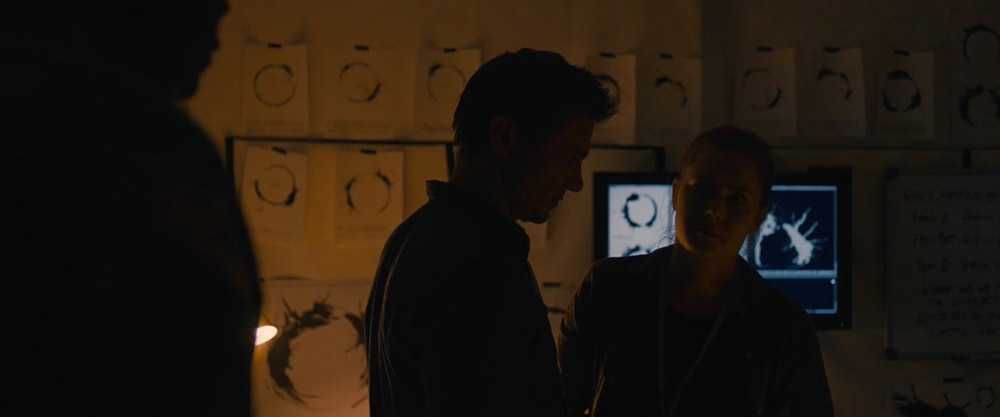
It is in this sense that Tijana Mamula astutely observes that “in addition to narrativizing Banks’s Heptapod-influenced perceptual shift, the film also articulates it formally, so that as she acquires the new language, we literally see her seeing the world in an increasingly different way” (543). Like Chiang, Villeneuve tells two stories, one causal and one teleological. And it is the latter that places the highest demands on the filmmaker and audience. For the “formalization” of Chiang’s compound tense time-travelling strategy, Mamula continues, “is especially significant in so far as Villeneuve equates Heptapod with cinema […] we might even say that the aliens teach Banks to see, think and experience cinematically” (543; emphasis in original). Film syntax offers an alternative linguistic register with which to negotiate the compoundtense incarnate in Chiang’s unutterable semagram. The film’s proleptic grammar visually actualizes Louise’s language acquisition, an enactment facilitated by a shared posture concerning temporality between Heptapod B and film montage. As Louise gains fluency, she is simultaneously teaching viewers how to discern and decode the silent visual grammar of editing upon which film time is constructed.
Because of the way English names tense, Louise’s simultaneous awareness is quickly evident in Chiang’s story, and he showcases the language’s remarkable flexibility in balancing different tenses against one another. The central quandary of transposing ambiguous predication into the “language” of cinematography is also of major thematic concern for Villeneuve. How, then, does film picture time? How does it sound out and announce departures from the present tense? The question of cinematic tense has long been a matter of debate among film theorists. Many, Béla Balázs foremost among them, have posited film’s tense as an eternal present. In his Theory of the Film (1945), he argues that films “show only the present—they cannot express either a past or a future tense” (120). George Bluestone, in his 1957 comparative analysis Novels into Film, would follow suit with his influential observation that “[t]he novel has three tenses; the film has only one. From this follows almost everything else one can say about time in both media” (48).
It is Deleuze who offers the most strenuous refusal of this position, averring that “the cinematographic image is in the present only in bad films” (39). His stark claim stems from a conviction that “[t]he postulate of ‘the image in the present’ is one of the most destructive for any understanding of cinema” (39). Cinema’s radical potential lies in its capacity to express the complex flow of time, the manner in which our human experience of the present is always permeated with past memories and future fantasies. Deleuze’s cinema books chart a shift in modern film, which withdraws from classical cinema’s depictions of active protagonists whose desires drive forward the narrative in a chain of cause and effect. Instead of this action-oriented focus on “physical movement” in space, modern cinema reflects on mental “displacement in time,” conveying “that Proustian dimension where people and things occupy a place in time which is incommensurable with the one they have in space” (39).
This displacement finds expression in discontinuity editing, which fractures linear and causal links between shots, but also (in a manner that succinctly pinpoints the temporal crux) within the frame of a single image. Such “time-images,” in Deleuze’s taxonomy, disclose a temporal depth of the moment, with different tenses superimposed in a style that captures the compound human experience of time.4 In this vein, Sarah Cardwell offers a reading of cinema-time that suggests the medium’s special ability to accommodate such temporal layering. She contends that the film “image is not ‘present’ but tenseless” (87, emphasis added). Cardwell draws this distinction based on the fact that while tense is a grammatical property of literature, the present tense is produced entirely as a perception of the film image. It follows, then, that if the present tense is not inherent in the film image, the filmmaker can also manipulate the viewer’s perception of time, transposing the “subtleties of literary tense directly into the visual text” (88).
This understanding of manipulated or transposed tense resonates with David Bordwell’s observation that “[l]acking a tense system like language, cinema has devised other time signals” (n.p.). An image’s pastness or futurity can be denoted via voice-over or text, when films draw on the capacity of language (whether speech or writing) to name time. Alternately, past and future can be evoked in a less exact manner: a shift that we can sense (that is, see, hear or feel) without precisely understanding. Most often, temporal shifts are created through a visual treatment of the image (commonly, colored filters or selective lighting) that marks a distance between our viewing position and that of the scene viewed. Shallow focus has a similar effect on the flashback’s visual dimension, separating planes of the image and suggesting our inability to grasp it in its entirety. Such focus spatializes time, placing a semi-transparent or clouded obstruction between viewer and object. Dissolve transitions similarly suggest an ephemeral grasp of shifts in time. Sonically, pastness is evoked through non-diegetic music and voice-over (among other less common sound effects such as echo).
In Arrival’s opening monologue, Louise delivers a statement that speaks broadly to the human experience of temporality while also more pointedly providing instructions for viewing the film. “We are so bound by time,” she reflects, “by its order” (00:01:50). The linear experience of time confines and constrains. Films can replicate this bind, or even intensify it. To watch a film, particularly one in the science fiction action mode, is to be carried away by the forward momentum of plotting. However, Louise’s remark invites us to examine critically the mechanisms through which linear time is rendered conventional, even when memory becomes part of the plotting or back story. The opening sequence uses both non-diegetic music and voice-over to generate the effect of a flash-back. We are experiencing the filmic equivalent of Chiang’s grammar, where one tense is held in suspension with another. The term voice-over encourages us to imagine the voice as spatially distinct from the image, often looking back in retrospect. Most typically employed for exposition and commentary, this positioning suggests an acousmatic perspective of omniscience. This voice is above and beyond the images it narrates, a sense of transcendence that is enhanced technically through sound mixing that isolates the voice from the image. As Michel Chion observes, the voice-over is traditionally distinguished from dialogue through close miking and an absence of reverb (51) that combine to communicate the spacelessness of the voice, its displacement from the scene depicted. Louise marks this distance in the film’s opening: “I used to think this was the beginning of your story” (00:01:31). These formal gestures generate a torsion of two tenses—one that is seen and one that is heard—superimposed within a single shot.
While such devices indicate a film’s departure from linear plotting, the trouble with Arrival is that most of these signals are deeply ambiguous: they indicate only a temporal disjuncture without pointing precisely in which direction we are headed. Viewers who have not read the novella will most likely deduce that they are watching flashbacks of Louise’s domestic life before her encounter with the Heptapods. Villeneuve’s temporal sleight of hand is effected here with the help of our habitual manner of re-ordering the exceptional moments in linear filmmaking. Our own memory (of viewing other films that feature this convention) superimposes “memory/pastness” onto what is otherwise an ambiguously marked image. The less obvious answer will elude most, saving for a reveal what was the premise in Chiang’s story: we are witnessing a series of flash-forwards that represent future events as if they have already occurred.
More poignantly than any other theorist, Roland Barthes dissects this crux of photographic tense. We view in photographic images, he argues, a “futur antérieur” (a term that expresses the temporal paradox more explicitly than the English “future perfect”). In his Camera Lucida, Barthes unfolds the complexity of this temporal kernel with a glance back at Alexander Gardner’s extraordinary photographic portrait of Lewis Payne, a confederate soldier sentenced to death for his attempted assassination of William Henry Seward in 1865. The “future anterior” of the photograph tells us both that Payne will soon die and that he has already died. Barthes understands at once: “this will be and this has been” (96). Barthes’s reading of the photograph’s future anterior names a temporal contradiction that structures all such indexical images. We affirm this strange temporal disjuncture whenever we take a photograph: mentally and physically, the act dislodges the photographer from the present moment. The subject of a portrait must perform a similar deferral, pausing (and posing) the present for the benefit of a future past when we will look back upon it. Barthes’s consideration of the photographic image is instrumental for our reading of the temporal ambiguity inherent in the film image, an ambiguity that Villeneuve exploits and shapes in his production of simultaneous consciousness. While “prolepsis” names Louise’s prescience, Barthes’s future anterior captures the pull of multiple tenses contained within a single image: Louise can not only grasp the future, but reach beyond it to a future past.
It must be said that Barthes had set out in Camera Lucida to discover an ontology specific to the photographic image, and more pointedly to explain his investment in “Photography in opposition to the Cinema” (3; emphasis original). In drawing together Deleuze and Barthes in our reflections on Arrival, then, we resist the notion that the affective charge and existential crisis occasioned by photography is bound to the medium’s essence. Deleuze’s time-image resonates with the future anterior of Barthes’ photograph insofar as both grant expression to the strain of tenses within an image. Arrival, for instance, repeatedly activates cinematographically the “photogenic” nature of the time-image through the use of sepia-toned filters that mark an image’s temporal alterity, and brief “flashes” of insight (whether back or forward) that borrow from the photographic register to signify illumination and exposure.
While the voice-over in the opening montage generates the emotional ambivalence through which Louise experiences Hannah’s foreshortened life, the sequence ends (and Arrival properly begins) with an enigmatic and even ironic statement that resists this narrative convention and troubles our understanding of what we have just viewed: “And now I’m not so sure I believe in beginnings and endings anymore” (00:02:59). Summoning us back into the sequence, this statement invites us to quiet the voice that imparts meaning so that we may perceive the silent work of editing that orders images into time. Responding to the formal problem of simultaneous consciousness in Chiang’s text, Arrival presents itself as working within the continuity system—the intent of which is to preserve the fluidity of events while trimming away any unnecessary temporal lag—but troubles this logic with sudden eruptions of discontinuity. As if turning pages in a photo album, the montage sequence is an exemplary tool of continuity editing: film syntax in the prose style, where the aim is clarity, coherence and concision. Yet, as Louise’s statement suggests, there is something else at play in the same diegetic field, a temporal ambivalence that reverberates with Deleuze’s “split present,” which proceeds “in two heterogeneous directions, one […] launched towards the future while the other falls into the past” (81). To view Arrival is to move along a path that is not linear but palindromic. The opening montage inaugurates this split trajectory, in a gesture bookended with the film’s near-mirrored closing montage. Each of these sequences must be viewed as prologue and epilogue, read forward and backward as analepsis and prolepsis. Employing a poetic syntax full of elisions and attendant condensations of meanings that are less in service of narrative than complex statements about time, causality and metaphoric associations, montage establishes Arrival’s signature present tensile tense.
In what follows we focus on two segments of the film that generate divergent thematic variations on time and narrative. Both are what we might call “processing” scenes, which, considered in the film’s reverse order, deal with the problem of learning Heptapod B and its proleptic influence on Louise. The first demonstrates linear time through continuity editing, while the second expresses teleological time through discontinuity editing. Together, they provide a clear picture of the way Villeneuve’s cinematographic language remediates the variational predication of Chiang’s story and the Fermatian principle upon which it is constructed.
The first scene exhibits one of the more familiar ways in which films play with time through editing. Just shy of its midpoint, the film breaks into a skillfully composed montage sequence that delivers dense exposition in the style of a “summary report” from the research team (00:52:25-00:55:51). The sequence has the feel of a documentary, with Ian delivering the mode’s classic authoritative “Voice of God” narration. Accompanied by the non-diegetic score, Ian’s observations carry us over a mixed visual terrain that corroborates the story without ever troubling it, exhibiting visual evidence of the processes that lie behind the scientist’s claims. Such sequences perform a vital function in science fiction film, which must often deliver a soft gloss on hard science. Ian’s self-effacing charm makes him a fine fit for the role, aligning him tonally with Neil deGrasse Tyson and other contemporary popularizers of science. The purpose of such montage sequences is to condense and compress time, offering a fractured but coherent portrait of a lengthy procedure. In the gaps between shots, we intuit the long hours of labour (formulating hypotheses, collecting materials, and experimentation) that have yielded these conclusions, but we are not subjected to the painstaking process. Just as the cause-and-effect logic of scientific discourse flows naturally through purposeful editing in this short film-within-the-film, continuity editing offers the viewer security in sustaining the film’s progress towards its crisis.
Louise’s processing sequence (which directly precedes Ian’s) takes the teleological measure of time by unlocking the proleptic energy of the semagram (00:51:23-00:52:25). Aiming for expansion rather than compression, her montage requires a different formal strategy. Notably, Louise’s processing work on Heptapod B is wordless, corroborating Ian’s hypothesis that “unlike speech, a logogram is free of time” (00:54:54). Heptapod B is not a transcription of speech, nor will the images she manipulates (nor those that shape her) be reduced to illustrations. Taking up a ruler, Louise begins to dissect a semagram (see Figure 7), dividing the image into quadrants (00:51:50). The first stroke along the rule produces a surprisingly loud noise, sounding as if the paper had been cropped with a guillotine. The amplified sound startles Louise, so exaggerated is this effect of her action. This strike through the semagram produces a tear in the film’s temporal structure as well, a disjunction expressed in an oblique audio cut. Before it, we hear the surrounding sounds of the lab; after, a J-cut abruptly replaces the ambient noise with the sound of wind. The source of the sound, alien to Louise’s immediate environs, is only belatedly revealed. This style of sound bridge disorients because—synchronized with Heptapod temporality—it delivers an effect that precedes its cause.5
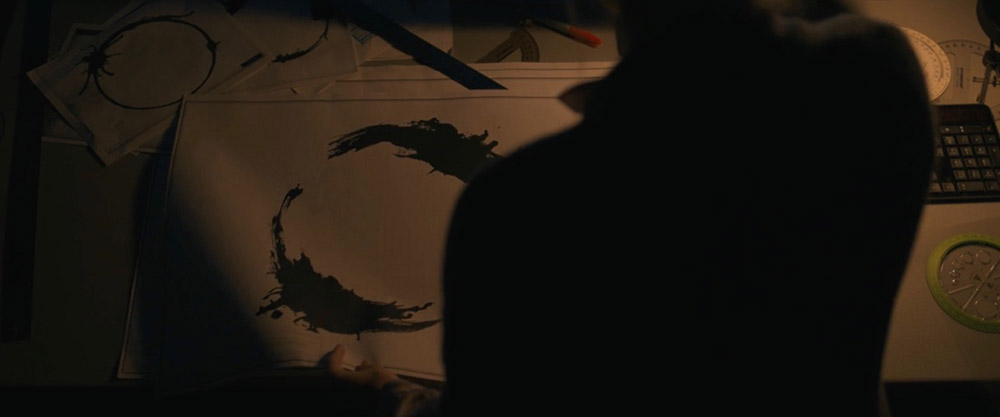
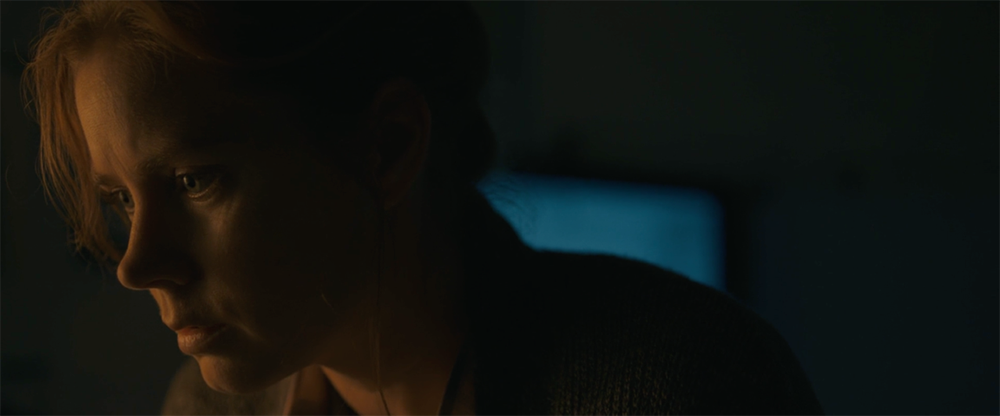
Louise has cut across, but also cut into the semagram. The act is captured in a close-up that frames not Louise’s active hand but the famously receptive face of actor Amy Adams (see Figure 8). Balázs has argued that the close-up does not just slice apart bodies (as Mulvey’s critique of fetishism would later assert [1975]), but pierces into the subject. In his chapter “The Face of Man,” Balázs credits the close-up not only with widening our vision of life, but deepening it, claiming that the camera “has uncovered that cell-life of the vital issues in which all great events are ultimately conceived” (314). From Louise’s close-up, we jump to a series of images of her daughter Hannah “conceived,” as Balázs would have it, within her consciousness. We might be tempted to read these montage shots—shuttling back and forth between Louise in the tent and (the still displaced) Hannah in nature—as one might a dream. The sound of the trickling water brings Louise’s “stream” of consciousness pouring through from the future into the present. Following this line of audio-visual associations, one discerns an element of condensation in the crooked stick that Hannah uses to “stir up the waters,” which recalls in its form, colour and movement the Heptapod’s articulated (and articulate) limbs. Whatever meanings are derived from these images, they emerge without the stabilizing narration of a voice-over that would spell out the connections between them. When Hannah turns over a rock in the stream, for instance, is this a symbol of Louise’s research (“no stone left unturned”)? As spectators, we speculate and conceive these links within ourselves. Associations develop via graphic matching. Hannah holds up for inspection a caterpillar; its backward arch bears a distinct resemblance to the whiskered curl of the semagram Louise has just dissected (see Figure 9), suggesting that the daughter is writing to her mother from the future in the trans-temporal language they now share. While the high-angle shot of Hannah’s partially submerged stick does not supply a visual representation of Fermat’s refraction graph (showing instead reflection [see Figure 10]), the recurrent sound bridges that stitch together the montage deliver an audio refraction that emphasizes the sonic dimension of the daughter’s reach through time. Like a proleptic ultrasound, Hannah is drawn into the present as acousmêtre, expressed in the tenseless language exchanged between a mother and her unborn daughter.6

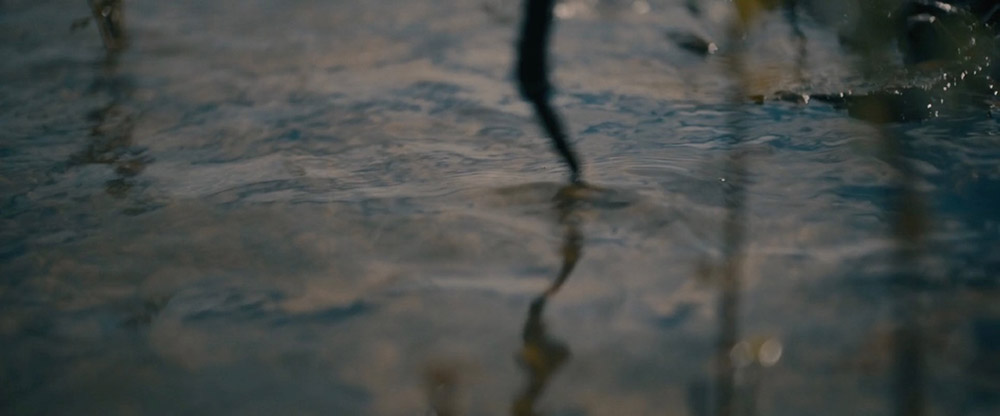
The circularity of this relation is inscribed from the start in Hannah’s name. Etymologically, she reaches back to the Hebrew: the name means “favour” or “grace,” derived from the First Book of Samuel where Hannah, struggling with a “barren womb,” rejoices that God has answered her prayers and favoured her with a child. Grasped as pure form, however, “Hannah” is a palindrome (from the Greek, “running back again”). An innovation of the screenplay (nameless in Chiang’s story she is simply addressed as “You”), Hannah can be read, and must be viewed, backwards and forwards at once. Her death and birth in hospital are bound together in the opening and closing montage sequences, and the existential dilemma these twinned events pose to Louise generate the film’s pathos. Louise can not only grasp the future, but must reach beyond it to a future past. This torsion generates the temporal and emotional ambivalence of what Mamula calls Hannah’s “premature death” (542). But what makes this occurrence “premature”? To ask would betray one’s critical insensitivity. It is an event thrown tragically out of sequence. Our language lacks even a word for this untimely loss, which makes an “orphan” of the parent, suggesting the difficulty of coming to terms with this usurpation of parental power to protect. The story’s reflections on the ambivalence of human will are only compounded by such an experience of parenthood rendered all the more painful by the fact that Hannah’s death is itself a process that precedes, almost romantically, her parents’ union.
While the film works to reassert the redemptive power of the American military/intelligence complex, the familial drama underlines the powerlessness of the parent who cannot save her child. Louise closes her story with a question that her simultaneous consciousness cannot resolve: “am I working toward an extreme of joy, or of pain? Will I achieve a minimum, or a maximum?” (145). This is not a matter of story (which Louise well knows), but affect (which still vexes). The trajectory of joy and pain is the same, and Louise’s simultaneous consciousness amplifies the feelings that are inextricably one and the same: every atom of love for Hannah ultimately deepens the loss. As Rebekah Sheldon has recently argued, science fiction convention has primed us to imagine the child to come as the personification of futurity and possibility. Working through Lee Edelman’s queer analysis of “reproductive futurity” in No Future, Queer Theory and the Death Drive (2004), Sheldon critiques the manner in which heterosexual reproduction nails down the future’s horizon as a mere perpetuation of the status quo, of reproduction as replication. Sheldon’s child is a symptom of heteronormative culture’s inability to imagine its own limit or obsolescence. But Chiang and Villeneuve’s hard lesson for Louise is that Hannah’s embodied futurity is simultaneously finitude epitomized.
In the diegetic world of Arrival, conflicting readings emerge from divergent understandings of finitude and futurity. A climactic equivocal Heptapod pronouncement delivers the characters to a moment of interpretive crisis. At first blush, the message, intercepted from a member of Russia’s science team, reads as a threat: “In their final session, the aliens said: ‘There is no time. Many become one’” (01:23:15). “No time,” heard the first time, sounds as if time has run out. This is the escalation of drama that we expect to see in a film’s closing act, the climax of a plot, where urgency demands decisive action. The countdown, it would seem, has begun. As viewers, we have come to expect that dramatic narrative films—particularly those in the action mode—will at the appropriate moment tap on the sand in the hourglass: the film as well as the characters are running out of it, and we expect both to sprint to the finish line—a quickening expressed through tightened plotting, rising allegro score, rapid editing, and other techniques of formal acceleration.
In its own way, Villeneuve’s film delivers on this count, with a climax that finds Louise being chased by armed guards through the base camp (01:40:55). Swiping Agent Halpern’s (Michael Stuhlbarg) satellite phone, Louise reaches out to General Shang (Tzi Ma), who, at the risk of instigating a global war, intends to launch a pre-emptive attack on the alien craft. On discovering this leak, Halpern is ready to shoot Louise to prevent the connection to the foreign power. The chase sequence is depicted through cross-cutting, a technique of film drama that presents two contiguous events unfolding at the same time, but in different places. This editing technique grants viewers a glimpse of simultaneity, creating suspense by toggling back and forth between parallel scenes destined to converge. Will these lines intersect too late, or just in time? Arrival, however, transforms the cross-cut so that Louise simultaneously occupies two spaces and times: she flashes forward to find the General at a formal gala, where/when he thanks her for reminding him of his wife’s dying words: “In war there are no winners, only widows” (01:43:05). The General’s sentiment is compelling enough, but doubtless it moves him because it speaks to a widower. The adage recontextualizes grand geopolitical conflict within the emotional frame of familial loss. In the simultaneous “present” of our action finale, Louise relays these words back to Shang on the satellite phone; whether for their content or their provenance, they are enough to convince the General to withdraw his forces. Though she pleads with Ian to “buy me twenty seconds” (01:42:54), Louise has already run “out of time.” That is, she has exited the conflict bound together by the cross-cut, traversing that dynamic with a message drawn from a future that anticipates and reroutes the present moment of crisis into a gesture of peace that will ensure the security of the future. This editing gesture is the film’s final exposition of Fermat’s Principle: Louise simultaneously inhabits the point of departure and arrival of a series of actions that will enable a future bound to the common experience of loss. From Louise’s intimate memory of Hannah, Villeneuve directs action towards an affective image of the future perfect:this will be, this has been, this will have been.
In this paper, we have argued that Arrival’s problematics of adaptation are latent in the scientific principle of its premise. Straddling both the mathematical and biological sense of variation, our approach directs critical attention not only to the grammatical athleticism of The Story of Your Life, but also to what is generally overlooked but always present in film: the temporal push and pull on this inherently tenseless medium. The homology of adaptation afforded by Fermat’s Principle presses viewers to re-evaluate the narrative flexibility of the film image encountered in mainstream cinema. From this perspective, The Story of Your Life reads as if composed with a Heptapod-like memory of its cinematic future: an adaptation into a semasiographic cinematic style that exposes the silent grammar governing the moving image’s temporal notation.
1 Variational calculus considers functions that generate values in equations in which the input is itself a function (i.e., a variable).
2 Hutcheon and Bartolotti offer one such model based in evolutionary theory, identifying what they call “a homology between biological and cultural adaptation” that considers the tendency of cultural artifacts, like biological forms, to survive and thrive through replication and diversification in changing cultural environments (444). Eschewing the “evaluative discourse of fidelity” in favor of the more “descriptive” nature of evolutionary discourse (453), their model shifts the terms of adaptive “success,” from faithfulness to source, to survival over time.
3 From Bertrand’s designs, Villeneuve’s production team created a “logogram bible” composed of over one hundred fully composed Heptapod “sentences” (Zakarin).
4 Deleuze turns to the image of the crystal—emblem of pressure, condensation, and refraction—to describe how time-images apprehend this temporal nexus at what he calls “the point of indiscernibility, the mutual image” (81); that is, the indivisible coexistence of an actual image (our present objective perception) and a virtual image (one that is subjective, rooted in recognition, recollection, or reverie).
5 L and J-cuts are employed throughout the film to convey the embodied effect of temporal disorientation that attends Louise’s encounters with Hannah (e.g., 00:58:46 – 01:00:15 [“The show is called ‘Mommy and Daddy Talk to Animals’”]; 1:30:58 - 1:31:57 [“Who is this child?”]; and 01:33:08 – 01:35:22 [“Help me, Momma”]).
6 This double-vision is emblematic of Anne Carruthers’s characterization of Louise’s future memories of Hannah as “pregnant embodiment”: “In the context of this film, pregnant embodiment is split and decentred, because it is both understood to have happened and ‘not-yet’ happened to Louise’s body” (324).
Works Cited
Adams, Douglas. The Restaurant at the End of the Universe. Vol. 2 of The Hitch Hiker’s Guide to the Galaxy: A Trilogy in Five Parts. 5 vols., Heinemann, 1995.
Arrival. Dir. Denis Villeneuve. Paramount (2016).
Balázs, Béla. Theory of the Film: Character and Growth of a New Art. Translated by Edith Bone, Arno P, 1972.
Barthes, Roland. Camera Lucida: Reflections on Photography. Translated by Richard Howard, Hill and Wang, 1982.
Bazin, André. “Adaptation: or, the Cinema as Digest,” Film Adaptation, edited by James Naremore, Rutgers UP, 2000, pp. 19-27.
Bluestone, George. Novels into Film: The Metamorphosis of Fiction into Cinema, U of California P, 1966.
Bortolotti, Gary R. and Linda Hutcheon. “On the Origin of Adaptations: Rethinking Fidelity Discourse and ‘Success’: Biologically.” New Literary History vol. 38, no. 3, 2007, pp. 443-58.
Bordwell, David. “Arrival: When is Now?” Observations on Film Art, 23 Nov. 2016,
www.davidbordwell.net/blog/2016/11/23/arrival-when-is-now/. Accessed 25 May 2022.
Canavan, Gerry. “Living in the Future.” Science Fiction Film and Television, vol. 11, no. 3, 2018, pp. 491-97.
Cardwell, Sara. “About Time: Theorizing Adaptation Temporality, and Tense.” Literature/Film Quarterly, vol. 31, no. 2, 2003, pp. 82-92.
Carruthers, Anne. “Temporality, Reproduction and the Not-Yet in Denis Villeneuve’s Arrival.” Film-Philosophy, vol. 22, no. 3, 2018, pp. 321-39. doi: 10.3366/film.2018.0083
Chiang, Ted. Stories of Your Life and Others, Vintage Books, 2016.
Chion, Michael. The Voice in Cinema. Edited and translated by Claudia Gorbman, Columbia UP, 1999.
Deleuze, Gilles. Cinema 2: The Time-Image. Translated by Hugh Tomlinson and Robert Galeta, U of Minnesota P, 1989.
Edelman, Lee. No Future: Queer Theory and the Death Drive, Duke UP, 2004.
Mamula, Tijana. “Denis Villeneuve, Film Theorist; Or, Cinema’s Arrival in a Multilingual World.” Screen, vol. 59, no.4, 2018, pp. 542-51. doi: 10.1093/screen/hjy053
Mulvey, Laura. “Visual Pleasure and Narrative Cinema.” Screen, vol. 16, no. 3, 1975, pp. 6-18.
Sheldon, Rebekah. The Child to Come: Life After the Human Catastrophe, U of Minnesota P, 2016.
Stam, Robert. Literature and Film: A Guide to the Theory and Practice of Film Adaptation (Oxford UP: Blackwell, 2005).
Zakarin, Jordan. “Arrival Invented a New an Insanely Complicated Language.” Inverse, 2 Nov. 2016. www.inverse.com/article/23159-arrival-invented-new-complicated-alien-language. Accessed 25 May 2022.